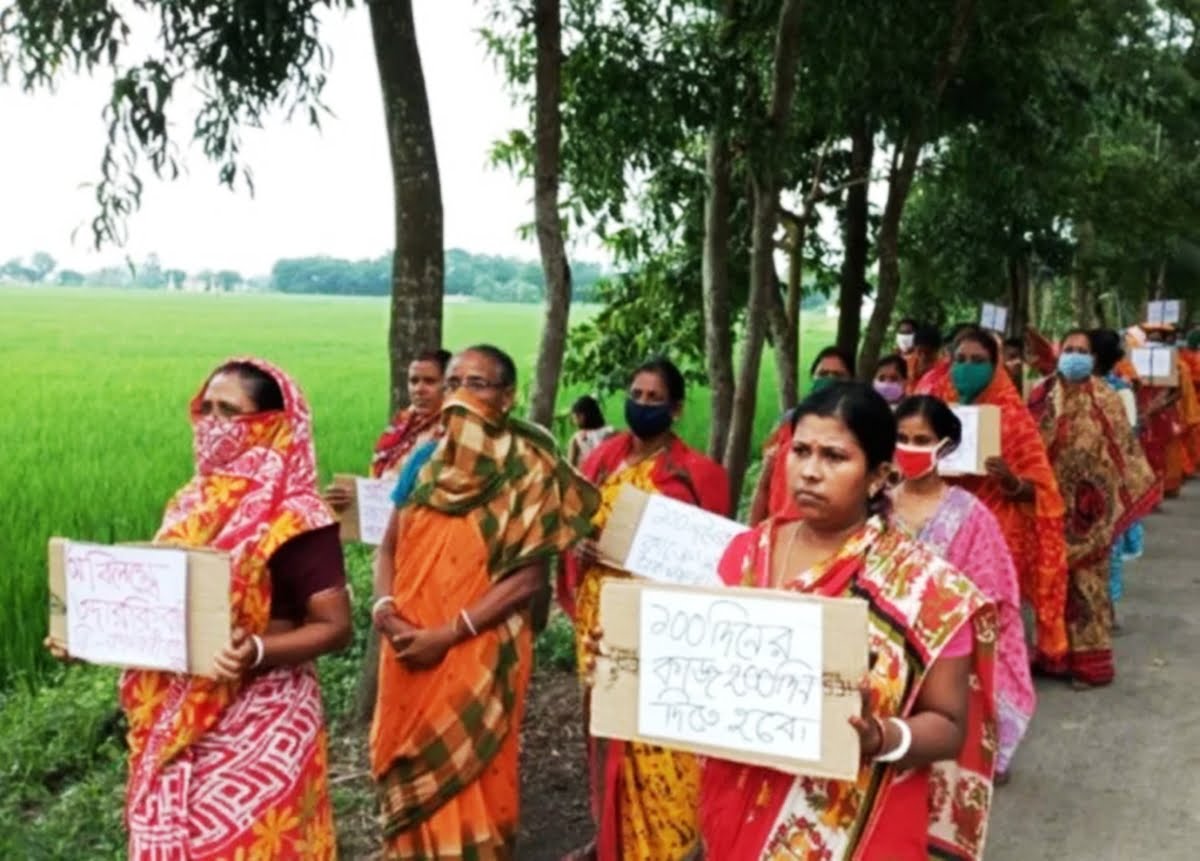Posted by Apurva Gupta and Debmalya Nandy
The Government of India has once again disappointed millions of rural citizens with a meagre allocation for the Mahatma Gandhi National Rural Employment Guarantee Act (MGNREGA) programme in the financial year (FY) 2022–23. Despite administrative flaws in implementation, technological glitches in execution, and leakages reported, MGNREGA has continued to be the only lifeline for rural workers—one that provides work and cash—in times of need and distress.
While the programme has never lived up to its true potential due to insufficient funding from the government, inadequate wages, and untimely payments, it is still the only employment provision that reaches out to large numbers of households in rural India and helps stave off extreme poverty and hunger. Despite this, the government has reduced the allocation to the MGNREGA programme to INR 73,000 crore for FY 2022–23—a sharp cut of 34 percent from the revised estimate of INR 98,000 crore last year.
Proper implementation of MGNREGA is a legal obligation of the state
This landmark programme has been systematically undermined over the years by the severe rationing of funds. As a result, the demand-driven nature of the act has been stifled into a supply-driven programme, with allocations determined by what the government is willing to spare versus what the people of rural India want.
This approach of indifference has translated into the government decreasing the allocation outlay for the Ministry of Rural Development by 12 percent in the Union Budget 2022–23, and that for the MGNREGA scheme specifically by 34 percent.
According to data by the Centre for Monitoring Indian Economy (CMIE), the unemployment rate in rural areas was 5.84 percent in January 2022. While this is a sharp decline from the 23 percent witnessed in April and May 2020—at the start of the nationwide lockdown—and on par with unemployment rates in March 2021, the disparity in incomes between poor and rich households has only been increasing. The latest survey conducted by the People’s Research on India’s Consumer Economy (PRICE) revealed that the share of the poorest 20 percent—which accounted for 5.9 percent of the total household income in 1995—has dropped further to 3.3 percent in 2021. On the other hand, the share of the richest 20 percent has jumped from 50.2 percent to 56.3 percent in the same period.
Budget allocations for MGNREGA have consistently fallen short of demand
During the national lockdown, a substantial amount of household expenditure was met through MGNREGA wages. With job losses and uneven income opportunities, the demand for work under this programme has only increased. While in FY 2020–21 the central government ended up spending INR 1.11 lakh crore (its highest allocation) for 11 crore workers from 7.5 crores households, in FY 2021–22, a 34 percent reduction in budget allocation resulted in significantly lower employment generation1 on the ground. The government later added a supplementary budget of INR 25,000 crore in view of the growing need for work across rural India.
For FY 2022–23, out of the allocation of INR 73,000 crore, about INR 18,350 crore is pending liabilities from previous years. Therefore, only about INR 54,650 crore is available for FY 2022-23. If we consider all the 9.94 crore households holding active job cards, then, given the current budgetary estimate, the government will be able to provide only 16 days at a per person per day average cost of INR 334.
Since 2015–16, the annual budget allocation has never been sufficient to provide work to all those seeking employment under the programme. In fact, every year about 80–90 percent of the budget is exhausted within the first six months of the year, resulting in a significant slowdown of work on the ground. Moreover, given lower budget allocations, state administrations tend to restrict the scope of implementation and jobs they put out. Therefore, a far fewer number of people end up working under the programme even though the real demand is way more than what the numbers on the website suggest.
In a pre-budget press statement, the NREGA Sangharsh Morcha—a collective of NREGA workers, organisations, and individuals working on NREGA in various parts of the country—had recommended that a conservative allocation of around INR 3.62 lakh crore in FY 2022–23 is required to ensure maximum employment generation for all active job card–holding families.
The recurring issue of delay in payments
In FY 2021-22, to date, 9.75 crore workers from 6.74 crore households have worked in NREGA despite frequent implementation bottlenecks due to delays in fund release from the Centre.
In the first half of FY 2021–22, 21 states and union territories showed a negative net balance, condemning workers to ‘forced labour’ by delaying wage payments. This cycle continues and adversely affects workers during the peak NREGA season in the final quarter of the financial year. As on 4 February 2022, 62 percent of wage transactions for the month of January is still pending to be released from the Centre.
According to Heavy Wait—a report by LibTech India, which is a collective of engineers, social workers, and social scientists who look at various aspects of governance and transparency—only 56 percent of the wages were transferred successfully in 15 days after the fund transfer orders (FTOs) were sent to the Government of India. The report also highlighted that the central government alone was responsible for delays in transferring wages for 71 percent of the total transactions. Another study by LibTech India found that the Centre was taking 24–26 days to complete the stage 2 wage transfer to the NREGA workers in Andhra Pradesh and Telangana respectively; this step should ideally take no more than 7 days, after which workers are entitled to compensation for each day’s delay. According to official sources, only 1.76 percent of payable delay compensation has been paid till January 30.
There is a need to strengthen social audits
In the past four years, media outlets have indicated heavy misappropriation in NREGA funds as reported by different social audit units. However, since social audits are not regularly held, our observations are that the volume of misappropriation is much more than what is reported in the audits.
In most states, the gram panchayat goes through the process of social audits once in three years, whereas in some states the audits do not take place at all. Moreover, all social audit reports are not hosted in the public domain. In 2021, Tamil Nadu accounted for the highest misappropriation of INR 245 crore, out of which only 3 percent of findings have been disclosed in the public domain. Additionally, only around 22 percent of gram panchayats across the country were audited at least once in FY 2021–22.
It’s time to do justice to MGNREGA in order to truly empower rural citizens
It is time that the Centre realises the true potential of NREGA and stops looking at it as just a legal compulsion. The programme must run as the demand-driven programme it was envisaged to be, with the true spirit of employment guarantee to rural citizens.
The government should therefore revise their budget estimate for FY 2022–23, so that there is adequate work for job card–holding families throughout the year without interruptions and payment delays.
We also suggest that action be taken to strengthen social audits across the nation by ensuring that independent social audits are regularised in all states, findings are put out in the public domain, and timely actions are taken against each irregularity.
We hope the government can leverage NREGA to help build a country where rural citizens are empowered with adequate work and dignified wages and resources can be deployed to improve incomes for the poorest households.
—
Footnotes
- However, the aggregate MGNREGA employment was still higher than pre-pandemic level.
- Any individuals of households who have worked any one day in either the current or the last three financial years.
- Average cost per person calculated at 12 percent hike from the current year.
- According to Section 3(3) of MGNREGA, 2005, workers are entitled to receive their wages within a fortnight of the date of closure of the muster roll.
- The MGNREGA payment process broadly consists of two stages. After the work is completed, an FTO is generated by the state government and digitally sent to the Centre, which is called Stage 1. In Stage 2, the central government processes the FTOs and transfers wages directly to the workers’ accounts.
Know more
- Learn about NREGA wages in different states.
- Read this case study to learn how panchayats in Jharkhand have activated NREGA.
- Understand why NREGA is crucial to rural India.
Do more
- Connect with Debmalya Nandy at debmalya22@gmail.com to explore opportunities for NREGA-related fieldwork.
This article has been republished from India Development Review with permission.
Featured image source: Paschimbanga Khetmajdoor Samity
About the author(s)
India Development Review (IDR) is India's first independent online media and knowledge platform for the development community.



